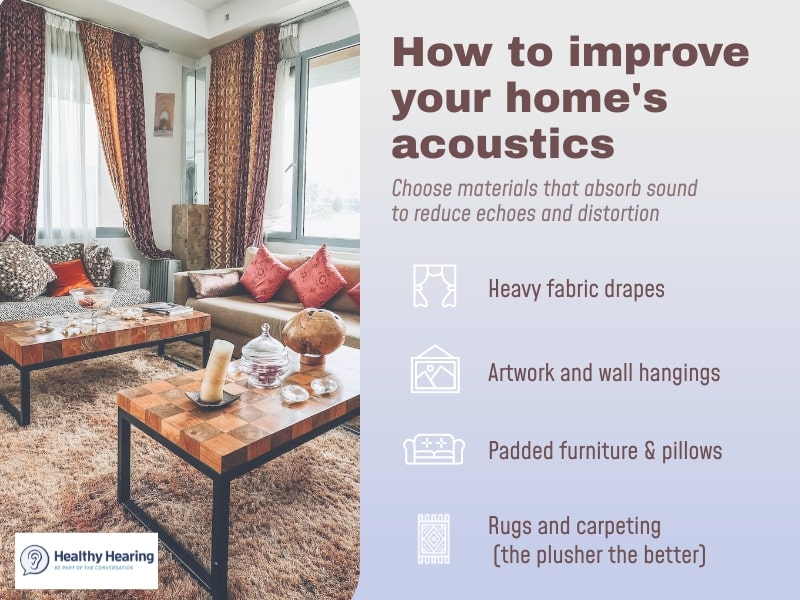
How to improve your home’s acoustics to hear better
At any time notice hearing in some places is particularly tough? Cavernous bars and noisy restaurants with stark walls and tables sans tablecloths can be especially difficult. But so as well can your household.
This is because of to acoustics, or how audio travels in a area or supplied area.
Get a substantial eating place with wood flooring, bare walls, and large, curtain-absolutely free windows—sounds bounce off all of those difficult, reflective surfaces, so you’ll listen to equally what an individual suggests and an echo, points out Lindsay S. Creed, AuD, CCC-A, affiliate director of audiology procedures at American Speech-Language-Listening to Affiliation (ASHA).
 


of audio-absorbing supplies.
How the wrong acoustics make it more difficult to hear
This echoing distorts the clarity of speech, she states. With far more stuff in a room—a tablecloth on that table, drapes above windows, rugs on the floor—sound is captured and absorbed by the softer surfaces, relatively than bouncing again.
“It [acoustics] can have a substantial impact on somebody’s communicative capacity,” Creed states. Which is real for every person, not just people today with listening to decline or these who wear hearing aids, she notes.
The good news is, there’s a great deal you can do in your property to improve the acoustics, making communication a lot easier.
Recent layout trends usually are not very hearing-helpful
“What’s attractive to the eyes is not always attractive to the ears,” Creed claims.
That is, today’s homes—designed with open spaces for entertaining, material-totally free windows, uncarpeted flooring, and vaulted ceilings—may be aesthetically on-trend, but these models also have unintended consequences when it will come to hearing.
“It would behoove us for interaction to actually have much more furnishings, additional carpeting, much more material materials for sound absorption about the dwelling and not just tough surfaces and walls,” Creed states. “Unfortunately, this recent interior structure aesthetic that is preferred by lots of is not fantastic for the ears and communication,” she says.

“What’s attractive to the eyes just isn’t constantly appealing to the ears.”

Some materials take in audio (imagine: fuzzy, comfortable, and textured resources), although other people reflect it, states occupation therapist Kristen Marie-Weber Chang, adjunct school at Concordia College Wisconsin, who also works as an occupational therapist at Mayo Clinic, Rochester, MN. That consists of glass, brick, and tiled surfaces, she states.
The trickiest rooms: Kitchens, bathrooms and laundry rooms
Some areas can be specifically challenging when it will come to listening to, points out Chang. That’s the rooms the place we’re minimum probable to use sound-absorbing fabrics and home furniture, this sort of as:
- 
- The kitchen: These rooms have tiles, really hard surfaces, and steel appliances, she notes. Furthermore, there may possibly be a dishwasher or other appliances emitting noises.
- Bathrooms: As with a kitchen, tile is a huge aspect and history noises (the working shower, the flushing toilet) can interfere with hearing.
- Laundry rooms: A double whammy of significant appliances made with a smooth, difficult surface.



Figuring out the spots the place hearing—and hence, communication—will be far more tricky can lead to strategic conclusions.
“If you happen to be heading to have a definitely significant conversation with a person, maybe you should not do it in the kitchen area,” Chang says. Think about as a substitute executing food prep in the residing space or a carpeted house if you want to have on chatting with somebody, she says.

6 guidelines to boost your home’s acoustics
No require to completely redesign your household. (Though, if you are planning from scratch, take into account going away from open idea, and imagining about your ears as you look at the architectural ideas.) Here are compact, spending plan-friendly alterations that can strengthen the acoustics in your house.
1. Include carpeting
Wall-to-wall carpeting can make a major variance, but if which is not in your finances (or your aesthetic preferences), try incorporating toss rugs. Do so with caution, Chang says. “Many more mature adults are also at a larger hazard for falls,” she states. So, if you are incorporating a rug, use carpet tape to tack down the sides and slip a rubbing backing under that can assist maintain it in spot (and also absorb even additional seem), she suggests.
2. Install door sweeps
Not only will these put an end to drafts, but a doorway sweep can slash down on seems emanating from noisy rooms, like the bathroom or laundry area, Chang says.
3. Include furniture—and pick padded alternatives
The far more home furnishings you have in the area, the superior. And, if you are preparing on having new home furnishings, decide for merchandise that are large and padded, as opposed to minimalist and built from tricky surfaces, Chang claims.
4. Use cloth strategically
That consists of placing a tablecloth on your kitchen and dining room tables, and using major drapery, Chang states. Consider heavier drapes designed with sounds-absorbing materials to take up the most seem, she says. Even smaller factors, such as adding drawer liners in the kitchen (to minimize the clanking of silverware) and adding bumper pads to drawers, tables, and doors can be practical, she states.
5. Place up artwork
“You can dangle curtains or tapestries on the wall, that can also be visually attractive, but also support with the acoustics,” Creed indicates. And artwork can also be handy, she states.
6. Use space dividers
Alongside with aiding to take in audio, they make huge spaces scaled-down.
“All people very little issues are likely to assist to soak up and not replicate audio, which is likely to consequence in fewer reverberation and a superior conversation natural environment,” Creed claims.

Even smaller items, such as including drawer liners in the kitchen area (to decrease the clanking of silverware) and introducing bumper pads to drawers, tables, and doorways can be practical.

Always attempt to limit background sounds
And, of training course, never neglect the gains of restricting background sounds, Creed claims. If you want to concentrate through a online video chat, convert the HVAC process down or off, for instance.

Qualifications noise will make it harder to hear consonants (it’s the motive it’s really hard to know if anyone mentioned “cat,” “hat,” or “sat” with no relying on context clues). Mix this with hard acoustics, and persons will listen to a number of iterations of vowel appears, producing a communication nightmare.
Your hearing service provider can offer you suggestions, much too
Everyone benefits from an “awareness that the environment does affect someone’s interaction,” Chang claims. If you discover that there are distinct spots in your home where discussions are hard, you can make sure to stay clear of important chats there—or, consider measures to improve the acoustics.
An audiologist or listening to professional also can be beneficial listed here. They’re authorities in equally engineering and auditory rehabilitation, which consists of counseling, Creed states. “So in addition to creating variations to the listening to aids, an audiologist can sit down with a individual and even their interaction associates in the property and go more than approaches for conversation recommendations, healthful listening to behaviors that they need to use, or go over what areas of the household are complicated to them and arrive up with certain advice for them,” Creed suggests.